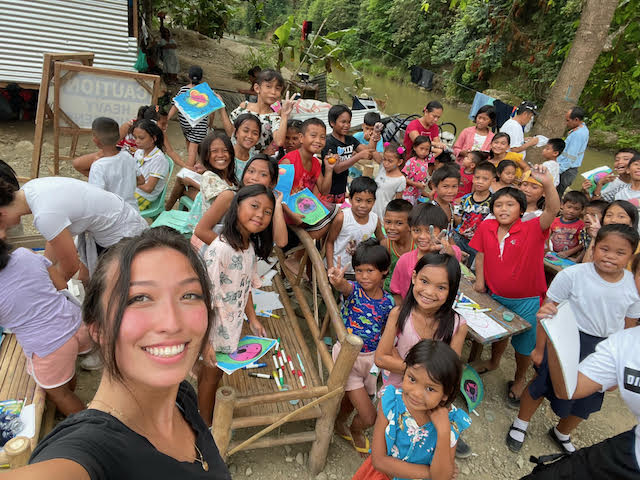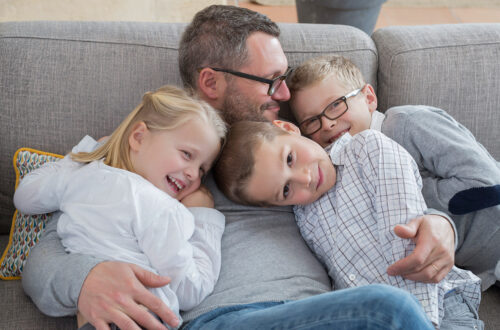These days you might find Ginhee Rancourt, 38, owner of Young Art in Santa Clara, jetting around the world bringing art lessons for free to kids in developing nations. Or maybe you saw her win this year’s Minority Women Lead award for entrepreneurs or YWCA Silicon Valley’s Tribute to Women Award.
But that’s not where she expected to be at 16 when her youngest sibling was born and she was planning a career in ballet. And her successes are definitely not what she wants you to take away from this story.
Ginhee founded Young Art as a for-profit art studio in 2013 in Oregon, and she opened studios in California soon after. Originally, it was a traditional mall-based art studio for kids. Parents would drop kids off for an hour of creative fun while they shopped – a service parents happily paid for.
What sets Ginhee apart from most business owners is her intense focus on what she calls her mission, to bring art and innovative thinking to children who can’t pay. Her mission has taken on huge proportions now, but she says that her philanthropy started just like any other small business.
“We would get asked by some low-income neighborhoods that had Title I schools to do donations just to their school,” she remembers. “Obviously as a startup you don’t have a lot of free cash to give but you have services.”
The for-profit business was thriving when the pandemic hit, and like other educational outlets, the studio went online. Used to providing hands-on fun for any random kid who walked through the door, Young Art had to make deep changes in their educational model.
That’s when Ginhee realized that although art is hands-on, video would allow her to expand access to her lessons. She started by offering video lessons to American public schools that had little or no funding for art. The classes were a success.
That success led her to cast her view more widely.
Going International
“Our dream is to connect the children here in the Western world with kids like their peers in the developing world,” Ginhee says, and she’s not one to let dreams lie still. In fact, she’s moving so fast that she hasn’t yet finished setting up the nonprofit to back the philanthropic efforts funded by Young Art.
She used her wide connections in the U.S. to find the first locations for setting up what she hopes to be a model to be replicated in any developing nation. Her first connection was with an American whose church does outreach in the Philippines.
A series of connections led Ginhee to Analiza Palaran, 43, of Catanico CDO City, Mindanao. Analiza, known as Ann, is a widow with five children who has dedicated herself to running Young Art’s free program on Sunday afternoons at her church. A teacher in the U.S. teaches the classes remotely, and not only are the students learning artistic skills, but Ann says they are also learning the principles of commerce.
“They put art in the frame and you sell it like a museum…in the public market in the city,” she explains. “I’m happy that the children are learning online so that when they grow up, the talent will help them to make money.”
Ginhee explains that her approach uses art to introduce children to design thinking and technology.
“When we are there visiting, we try to inject as much joy into that community with art supplies, art workshops, and really celebrate the joy of creativity with them. But then with the right pieces of technology they can continue their learning, so we [bring] some basic projectors and computers so we can do live classes with them each week.”
Ginhee hires local teachers on a California pay scale, which raises their standard of living, and students attend the classes in person or online for free. Another connection she made was with Dr. Sara Safari, founder and president of Climb Your Everest, a foundation that works to raise awareness of marginalized girls and victims of sex trafficking around the world. Ginhee first offered art supplies and video instructions, then joined Sara on trips to serve young women in Nepal and elsewhere. She has recently joined the board. Sara refers to them as “a team,” Climb Your Everest working with women to help them define goals and improve their lives, and Young Art offering children art lessons that have larger life lessons embedded in them.
“In one of the classes,” Sara remembers, “I was asking the kids, ‘What is the biggest problem you’re dealing with and how do you want to solve it? Create art, draw something, paint something.’ She was encouraging, engaging, inclusive.”
Sonam Gurung Sherpa, 36, who runs I.A.M. Trekking and Expedition with her husband in Kathmandu, Nepal, helped start classes in her local school after connecting with Ginhee through Dr. Safari.
“It helps them to know about the color mixing techniques, and the way to express your feeling through art,” Sonam explains. “Kids really enjoyed such programs; also they get refreshed.”
Madan Jung Shah, 43, runs schools and social services for poor children in Kailali, in far west Nepal. His work is funded by Marian and Suzie Noronha of New Hampshire, another couple driven by their faith to promote learning around the world, who are family friends of Ginhee’s. When Madan visited the Noronhas in the U.S., he met Ginhee and invited her to offer lessons in Nepal.
Madan’s work focuses mostly on girls, who he said have few prospects in western Nepal. “[The girls leave school to] help in their family, look after their goats, cows, buffalo, and look after the children. Especially in that particular culture, they think that a girl is going to get married to another family, so she doesn’t need education.”
Ginhee started by providing video training to teachers in the school. Madan says that he was initially skeptical about whether art had any value past personal fulfillment. “When I came to know Ginhee and Ginhee told us all about innovation I was blown away. We were amazed to see art has so much influence among the people. We talk about innovation, how our children can think and solve problems and come up with different ideas.”
The children in Madan’s school meet online with American children to talk about problems that they face, especially environmental issues. Madan believes that this interconnection is important because the children on both sides of the world will grow up to focus on solving problems together.
This year Ginhee visited the site in person with her younger sister Rubee. The photos of Ginhee’s visit include beaming children holding up their artwork. Although not affiliated with a religious instituation, Ginhee mixes faith-based and business terms when she describes her charitable work. It is clear that she uses the word “mission” with a meaning deeper than a business’s mission statement.
“For me, that’s the most inspiring part of our model right now,” Ginhee explains. “The studios in California where parents pay to drop off their child for an experience funds the goodness to these children on the other side of the world.”
Work ethic
Ginhee was born in Massachusetts to entrepreneurial parents. When Ginhee was small, her Korean-American mother instilled a sense of work ethic and goal-setting.
“She gave me an appetite for getting things done so she’d make me long checklists. I would have to do those chores and I used to like checking off the boxes!”
The eldest in her family, by the time Ginhee was sixteen she was dancing with a regional ballet company in the Pacific Northwest, where she lived with her parents and young siblings. She remembers her parents running a series of small businesses, from selling Korean pot stickers at a fair to house painting. Soon she realized that her intended career as a ballet dancer would have to take a backseat to her family obligations. She ran her parents’ small chain of boutique stores while caring for her large family, her parents were increasingly unable to provide for them. Barely out of childhood herself, she became surrogate mom and main breadwinner.
In 2013, now living in California and getting ready to leave the family business and start Young Art, Ginhee went to court and applied to be the guardian of all of her five minor siblings.
Ginhee hesitates to be specific about what led to her eventually being awarded custody, only referring obliquely to her own parents’ trauma which led them to not be able to care for the younger siblings.
“I have a lot of compassion because we all make wrong choices,” Ginhee says. “We didn’t have the traditional structure of parents anymore, but the good news is that we drew a lot of power and love and strength from one another.”
She acknowledges that she now knows how hard parenting is, and is happy that some of her siblings—the youngest of whom just graduated from high school—have reached out to their estranged parents.
“Like they say, hindsight’s 20-20 and I probably was ill-equipped for the task but I had good intent. So my business started with the intent of just doing what I could with what I had so I was able to take care of my siblings.”
Experiential learning
Perhaps the design of Young Art has more than a little to do with Ginhee’s experience learning to care for her siblings. The curriculum leans heavily on the idea of experiential learning, in which children learn by trying, failing, and trying again. Instead of lessons to teach them what is right before they start, the teachers help the students build a sense of adventure and exploration.
With traditional art as a foundation, the lessons now include components of engineering and design, especially in the developing nations that they serve. Led by local professionals in their native language or by video from California, students make art while learning to identify a problem and come up with solutions. Ann’s group in Mindanao, for example, realized that they could bring electricity to their village by harnessing the power of the river. They are working with their American peers to develop designs for simple water turbines. Madan’s students in Nepal are trying to solve their trash problem with the help of American kids.
But at the same time as the kids overseas benefit, Ginhee says, the Americans working with them learn sobering lessons about need. “It really does something to your heart and you just realize they’re growing up with no running water, no electricity. When we tried to face paint some of the children’s faces they would say, ‘Do you have bread?’”
Adversity breeds strength
On every measure, Ginhee is a success story. With her younger siblings on their way to or settled into young adulthood, she is an “empty nester” who has no children of her own. Nevertheless, Ginhee says she has regrets about her improvised parenting. She wishes she’d known how to help her siblings build the sort of strength that comes from facing obstacles.
“I was just a well-meaning older sister. Now seeing them as young adults I do see a lot of gaps. We did the best we could with what we knew.”
She says she definitely sees the contrast between her American students, who are compassionate but face few challenges in their lives, and her students in developing nations.
“Sometimes adversity creates a sense of being anti-fragile—it stems from just having challenges and obstacles in your way.”
Sara Safari says that Ginhee is an example of what people can do to improve their lives when they identify their own Mount Everest to climb.
“I compare it to mountain climbing. On the mountain, every single difficulty that happens you have to keep rising above that, you have to keep staying in the moment. You have to keep being okay with fears and failures. You have to be so present to your own power and believing in yourself. I think these women—like Ginhee—have been an example of that. There is a lot of hardship but they rise above every second, and that makes them resilient and strong.”
Ginhee says she takes an important lesson from superheroes. “They really take ownership of critical responsibility for mass preservation of humanity. So I never worry if Thor’s going to recover or if Superman’s going to make it. Their focus is always others-centric.”
Ginhee doesn’t want readers to leave with a sense of awe of her accomplishments, but rather a sense of how facing adversity, whether it’s caring for your siblings or climbing the mountain ahead of you, can make you a stronger, more productive, and more fulfilled person.
“They say that adversity produces character,” Ginhee reflects. “In comparison to the adversity I’ve seen, perseverance in Nepal and the Philippines, I don’t think that my adversity was particularly significant.”
Suki Wessling is a Santa Cruz-based writer, teacher, and podcaster. Her podcast, The Babblery, can be found at www.Babblery.com.








